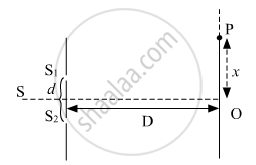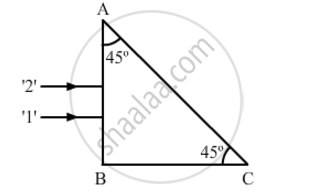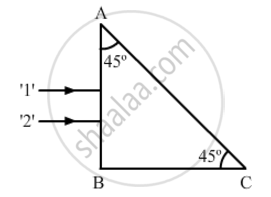Advertisements
Advertisements
Question
(a) Can the interference pattern be produced by two independent monochromatic sources of light? Explain.
(b) The intensity at the central maximum (O) in Young's double-slit experimental set-up shown in the figure is IO. If the distance OP equals one-third of the fringe width of the pattern, show that the intensity at point P, would `"I"_°/4`

(c) In Young's double-slit experiment, the slits are separated by 0⋅5 mm and the screen is placed 1⋅0 m away from the slit. It is found that the 5th bright fringe is at a distance of 4⋅13 mm from the 2nd dark fringe. Find the wavelength of light used.
Solution
(a) Two independent monochromatic sources cannot produce a sustained interference pattern. This is because the phase difference of two independent sources cannot be strictly constant throughout. A constant phase difference is essential to produce a distinguishable interference pattern. [Each of the sources produces their own diffraction pattern which interacts with each other. This interaction may or may not result in the interference pattern in case of 2 different sources but produces a clear pattern in case of coherent sources if d
(b) Fringe width, `beta = lambda"D"/"d"`
Here,
`"OP" ="x" = beta/3 = (lambda"D")/(3"d")`
`"x" = (lambda"D")/(3"d")` ..................(1)
∴ Δ X (Path difference) `= "x""d"/"D"`
∵ `"x""d"/"d" = lambda/3`......(From eq. 1)
⇒ Δ X ` = "x""d"/"D"`
φ (Phase difference) `= (2pi)/(lambda)(Delta "X")`
`= (2pi)/lambda xx lambda / 3 = (2pi)/3`
⇒ φ `= (2pi)/3`
If intensity at point O is IO, then intensity at point P will be,`"I"_"P" = "I"_"O" cos^2 (φ/2)`
`"I"_"P" = "I"_"O" cos^2 (φ/2) = "I"_"O" cos^2(pi/3)`
`= "I"_"O"(1/2)^2 = "I"_"O"/4`
⇒ `"I"_"P" = "I"_"O"/4`
(c) For Young's double slit experiment, Position of 5th bright fringe `=5xx (lambda"D")/"d"`
The position of 2th dark fringe = `(2 xx 2 xx -1) xx (lambda"D")/(2"d") = 1.5 ((lambda"D")/"d")`
Where D is the distance of the screen from the slits and d is the separation between the slits.
According to the given information,
`5 xx ((lambda"D")/"d") - 1.5 xx ((lambda"d")/"d") = 4.13 xx 10^-3 "m"`
⇒ `3.5 xx ((lambda"D")/"d") = 4.13 xx 10^-3 "m"`
⇒ `lambda = (4.13 xx 10^-3 xx 0.5 xx 10^-3)/(3.5xx1) = 0.59 xx 1^-6 "m"`
⇒ `lambda = 590 "nm"`
APPEARS IN
RELATED QUESTIONS
'Two independent monochromatic sources of light cannot produce a sustained interference pattern'. Give reason.
Two monochromatic rays of light are incident normally on the face AB of an isosceles right-angled prism ABC. The refractive indices of the glass prism for the two rays '1' and '2' are respectively 1.3 and 1.5. Trace the path of these rays after entering the prism.

Two monochromatic rays of light are incident normally on the face AB of an isosceles right-angled prism ABC. The refractive indices of the glass prism for the two rays '1' and '2' are respectively 1.35 and 1.45. Trace the path of these rays after entering the prism.

In the wave picture of light, the intensity of light is determined by the square of the amplitude of the wave. What determines the intensity in the photon picture of light?
Monochromatic light of frequency 5.0 × 1014 Hz is produced by a laser. The power emitted is 3.0 × 10–3 W. Estimate the number of photons emitted per second on an average by the source ?
"Monochromatic light should be used to produce pure spectrum". Comment on this statement.
Can the interference pattern be produced by two independent monochromatic sources of light? Explain.
State with reason, how the linear width of the central maximum will be affected if
(i) monochromatic yellow light is replaced with red light, and
(ii) distance between the slit and the screen is increased.
Monochromatic light of wavelength 600 nm is incident from the air on a water surface. The refractive index of water is 1.33. Find the
- wavelength,
- frequency and
- speed, of reflected and refracted light.
The Figure below shows a ray of monochromatic light LM incident on the first surface AB of a regular (equilateral) glass prism ABC. The emergent ray grazes the adjacent surface AC. Calculate the angle of incidence. (Refractive Index of glass = 1.5)

